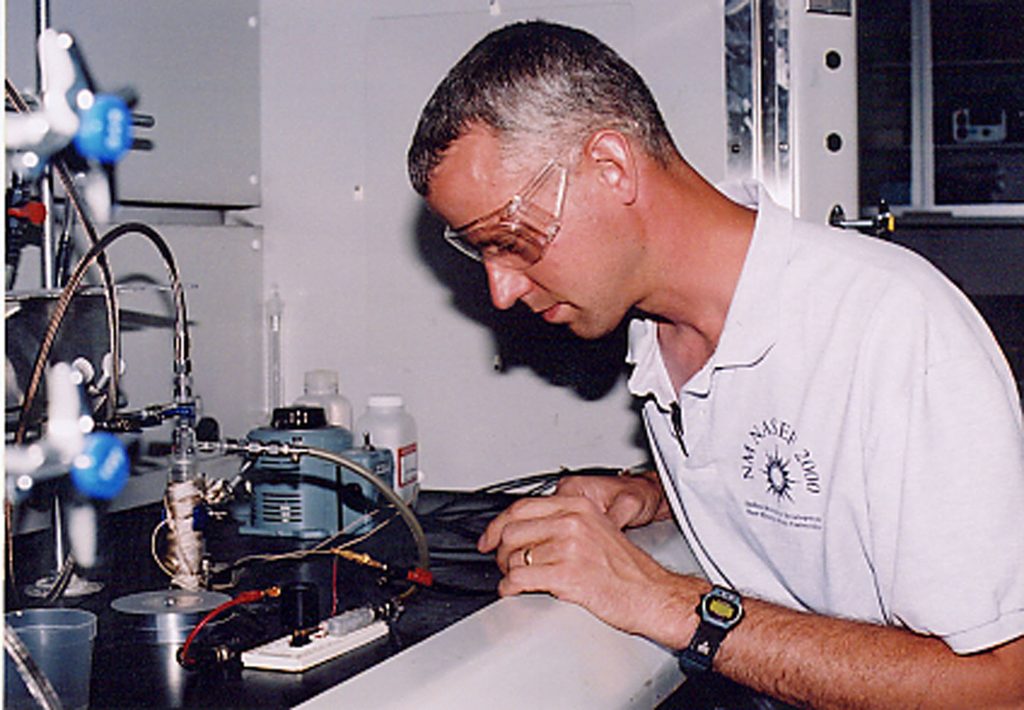
ALBUQUERQUE, N.M. — Tomorrow’s sensors, communication devices and other microelectronics technology may be powered by life. That is, powered by glucose obtained from living biological systems, ranging from human skin to plant tissues.
Sandia National Laboratories researchers Doug Loy and Kent Schubert are leading a three-year internally funded Laboratory Directed Research and Development (LDRD) Grand Challenge to develop new compact power sources for devices fueled by biological hosts such as plants or animals. The project, Bio-MicroFuel Cell Grand Challenge, could fill a need for uninterrupted autonomous power for applications where batteries are too large and/or too short-lived.
“We are initially looking at ‘harvesting’ glucose from living plants to serve as the power source for sensors,” Schubert says.
A fuel cell is an electrochemical energy conversion device that converts a fuel, typically hydrogen and oxygen, into electricity. Instead of hydrogen, the fuel for the bio-microfuel cell will be glucose from a living system. But like a hydrogen/oxygen fuel cell, the primary emission is water. The biofuel cell will also create a small amount of carbon dioxide.
But unlike a hydrogen fuel cell, which has to be refueled with hydrogen periodically, the bio-microfuel cell will continue to produce electricity as long as the plant or other biological host remains alive.
The grand challenge is divided into six research teams:
- Bio-MicroFuel Cell Architecture Team, which is designing a microfuel cell compatible with biofuels.
- Membrane Materials, Fabrication and Testing Team, which is making membranes more robust and more compatible with microfabrication techniques.
- Bio-Microsystem Interfaces & Surface Compatibilization Team, which is engineering the interface for harvesting the fuel.
- Electrodes/Electrochemistry Team, which is focusing on the oxidation of the fuel and incorporating the electrode structures into the micro-architecture.
- Biological Materials Team, which is working on integrating new bio-selective membranes and engineered enzymes for selective transport and oxidation.
- Systems Integration Team, which is integrating all components into one system.
To date the researchers have built several operational microfuel cells. They separately demonstrated the feasibility of converting glucose to electricity, but have not yet powered a microfuel cell with glucose.
The Sandia researchers are simultaneously developing two types of catalysts — one made from enzymes and one from a precious metal, probably platinum alloyed with other materials.
In its final form, the fully integrated system is expected to be the size of a small matchbox with a “harvester” tail protruding. The harvester will be a simple input device that could be a short needle penetrating into a living biological source, like a plant or a tree. Whatever the source, glucose-containing fluid will be drawn from the biological host. Then, using a membrane, the glucose will be separated from the fluid and oxidized in an electrochemical cell, producing electricity and water. The goal of the project is to produce a 100 mW bio-microfuel cell in as small a package as possible, sufficient to power small devices. With breakthroughs in a few key technical areas, it may be possible to achieve 100 mW/cm2 of output power.
Sandia Vice President for Science Technology & Partnerships Al Romig says the bio-microfuel cell work is a “classic example of Sandia expertise in engineering and physical sciences being applied to a biological system problem.”
“The results of this work will have a profound impact on our nation’s security and potentially our economic prosperity,” he says. “Without the interdisciplinary collaboration between physical and biological disciplines, these results would not be possible.”
Loy sees a lot of potential uses for the bio-microfuel cell.
“We anticipate the bio-microfuel cell will have a number of spin-off markets, particularly in the health care arena,” Loy says. “Such devices could be used, for example, to power pacemakers, using glucose in a patient’s blood as the fuel source.”
The project comes with several “grand challenges” to overcome, Schubert says.
“Although many people and a lot of money have been devoted for many years to the development of microfuel cells that burn hydrogen gas, it is noteworthy that such devices are not yet commercially available,” Schubert says. “Micro-sized direct methanol fuel cells are under development for consumer electronics such as laptop computers and cell phones. Though some may be close, none are on the market yet. In attempting to work with glucose or other bio fuels, the Sandia project is attempting to go even further.”
For example, an issue researchers must overcome concerns the fluid carrying the glucose, which has the potential for poisoning the catalyst. To overcome this, they are using two tactics — coming up with a way to purify the fuel before going to the catalyst and developing catalysts that are resistant to the poison.
“This is only one of many major technical challenges facing the bio-microfuel cell team,” Schubert says. “I’m sure there are some we don’t even realize yet, but the payoff for developing the capability will be enormous.”
Sandians are collaborating with leading universities to look at the role of membrane proteins in normal neurotransmitter function and after exposure to nerve agents (such as botulism, a toxin that shuts down the firing of neurons to cause paralysis).